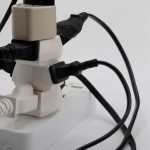Last Updated on 12 months by Francis
EMF home testing is the process of measuring the electromagnetic fields in a home. Electromagnetic fields (EMF) are present in all electronic devices and appliances, as well as in the environment. High levels of EMF can potentially have negative health effects, which is why it is important to test EMF levels in homes. In this article, we will discuss the importance of EMF home testing, how to do it, and what to do if high levels of EMF are detected.
Contents
What is EMF?
Electromagnetic fields (EMF) are present in our everyday life, and they are a type of energy that comes from electronic devices, power lines, and other sources. EMF can be categorized as either low frequency or high frequency, and they can have different effects on the body depending on their intensity.
Low Frequency EMF
Low frequency EMF is typically produced by electronic devices like televisions, refrigerators, and power lines. Exposure to low frequency EMF has been linked to an increased risk of cancer, as well as other health problems like headaches, fatigue, and sleep disorders.
High Frequency EMF
High frequency EMF is produced by wireless devices like cell phones, Wi-Fi routers, and smart meters. Exposure to high frequency EMF has been linked to a range of health problems, including cancer, DNA damage, and reproductive problems.
Why Test for EMF in Your Home?
If you’re concerned about the potential health risks of EMF exposure, it’s important to test for EMF in your home. Testing can help you identify areas of your home where EMF levels are high, and it can also help you make informed decisions about how to reduce your exposure.
Misconceptions About EMF Testing
There are a few misconceptions about EMF testing that are worth addressing. First, some people believe that EMF testing is only necessary if you live near power lines or other high-voltage sources. However, EMF can come from a range of sources, including electronic devices and Wi-Fi routers, so it’s important to test for it in all areas of your home.
How to Test for EMF in Your Home
There are a few different methods for testing EMF in your home. One option is to use a handheld EMF meter, which can measure the strength of EMF in a specific location. Another option is to hire a professional to conduct a more comprehensive EMF assessment of your home.
How to Reduce Your Exposure to EMF
After you’ve identified areas of your home with high levels of EMF, it’s important to take steps to reduce your exposure. There are several ways to do this, including:
1. Limit Your Use of Electronic Devices
One of the easiest ways to reduce your exposure to EMF is to limit your use of electronic devices. This might mean turning off your Wi-Fi router when you’re not using it, or using a wired connection instead of Wi-Fi.
2. Use EMF-Blocking Products
There are several products on the market that claim to block or reduce the amount of EMF that your body is exposed to. These include EMF-blocking phone cases and laptop shields, as well as clothing made with EMF-shielding fabric.
3. Create a Low-EMF Bedroom
The bedroom is one of the most important areas to focus on when it comes to reducing your exposure to EMF. To create a low-EMF bedroom, consider removing electronic devices like televisions and computers, and using battery-powered alarm clocks instead of electric ones.
FAQs for EMF Home Testing
What is EMF home testing?
EMF home testing is the process of measuring electromagnetic fields (EMFs) within your home using specialized equipment. These measurements can be used to identify potential sources of high or low EMFs, and to help assess your exposure to these fields within your living environment.
Why should I consider EMF home testing?
If you are concerned about the potential health effects of electromagnetic radiation, or if you are experiencing symptoms that you believe may be related to EMF exposure, EMF home testing can help you identify potential sources of these fields in your home. By identifying sources of high or low EMFs, you can take steps to reduce your exposure and improve your overall health and wellness.
What kind of equipment do I need for EMF home testing?
To perform EMF home testing, you will need a specialized meter that can measure electromagnetic fields. There are a variety of different meters available, from simple handheld devices to more advanced testing kits that include multiple sensors and data logging capabilities. The type of meter you choose will depend on your needs and budget.
What are some common sources of EMFs in my home?
There are many potential sources of EMFs in your home, including electrical wiring, appliances, wireless devices, and even building materials. Some common sources of high EMFs include cell phones, Wi-Fi routers, power lines, and smart meters. By identifying and addressing these sources of EMFs, you can reduce your overall exposure and improve your health.
How do I interpret the results of an EMF home test?
Interpreting the results of an EMF home test can be complex, and it is often best to work with a professional who is experienced in this area. However, some general guidelines can help you understand your results. In general, measurements should be compared to established safety guidelines, such as those set by the International Commission on Non-Ionizing Radiation Protection (ICNIRP). If your measurements exceed these guidelines, you may want to take steps to reduce your exposure.
Can I perform EMF home testing myself, or should I work with a professional?
While it is possible to perform EMF home testing yourself using a meter, it is often best to work with a professional who can provide expert guidance and interpretation of your results. A professional consultant can help you identify potential sources of EMFs in your home, and can provide personalized recommendations for reducing your overall exposure. If you do choose to perform EMF home testing yourself, be sure to educate yourself on proper testing techniques and equipment usage.







